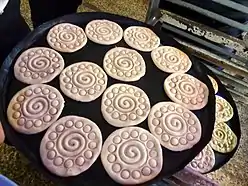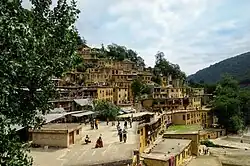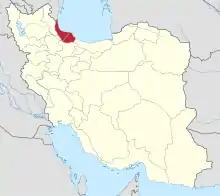Fuman, Iran
Fuman (Persian: فومن Fuman)[lower-alpha 1] is a city in the Central District of Fuman County, Gilan province, Iran, serving as both capital of the district and of the county.
Fuman
Persian: فومن | |
|---|---|
City | |
Top to bottom, left to right: A street in Fuman, Gilan; Fouman's Anahita Statue; Fouman's Old Public Bath entrance tiles; Fouman's Rudkhan Castle; Masouleh, a historial city in Fouman county | |
 Fuman | |
| Coordinates: 37°13′27″N 49°18′45″E[1] | |
| Country | |
| Province | Gilan |
| County | Fuman |
| District | Central |
| Population (2016)[2] | |
| • Total | 35,841 |
| Time zone | UTC+3:30 (IRST) |
At the 2006 National Census, its population was 27,763 in 7,728 households.[4] The following census in 2011 counted 30,608 people in 9,332 households.[5] The latest census in 2016 showed a population of 35,841 people in 11,849 households.[2]
Rice has been cultivated in this region for many years, where some indigenous cultivars were conventionally bred by farmers.[6] Fuman also produces popular cookies known as koluche. Fuman's koluche is thinner and larger than its brethren in Lahijan.
The city is also known for its statues, including the statue of the ancient Iranian goddess Anahita and the statue of the Four Girls.
Location
Fuman is only 21 kilometres to the west-southwest of Rasht,[7] and 356 kilometres away from the national capital Tehran. It is situated near the foothills of the Talysh Highlands.[7] Fuman is on the road to the historical city of Masuleh and as a result receives a sizeable number of tourists.
History
From 660 to 760, Fuman functioned as the seat of the Zoroastrian[8] Dabuyid rulers.[7] During the period of the Mongol occupation of Iran, Fuman and Lahijan were among the main towns of Gilan.[7] The local ruler of Fuman at that time, who was reportedly the "only Shafi'ite among the rulers of Gilan", was able to generate a large amount of revenue through lucrative silk trade.[7] According to Hamdallah Mustawfi (died 1349), Fuman was a large city, and the center of a wealthy region which produced large quantities of "wheat, rice and silk".[7]
Fuman continued to function as the capital of the Bia-pas region (western Gilan) until 1572–1573, when ruler Jamshid Soltan made Rasht the capital.[7][9] From the reign of King (Shah) Sultan Husayn (r. 1694–1722) to Fath-Ali Shah Qajar (r. 1797–1834), the local rulers of Fuman were involved in a fierce rivalry with the local rulers of neighboring Shaft.[7] John Elton, who had been prominent under Nader Shah (r. 1736–1747), was killed in 1751 on the order of one of these rulers, Agha Jamal Fumani.[7] In 1805, during the reign of Fath-Ali Shah Qajar, Fuman was reportedly "still a small, open town with about a thousand houses and a very lively market".[7] However, the situation changed when Hajji Mohammad Khan abandoned Fuman for Rasht during the early reign of Naser al-Din Shah Qajar (r. 1848–1896). In the subsequent period, Fuman "fell into decay".[7] According to Grigorii Melgunov, who visited Fuman in 1860, it was little more than a village consisting of just 140 houses surrounding the palace of the local ruler.[7] Fuman has regained importance since the mid-20th century.[7]
Demographics
The majority of the inhabitants are Shia Muslims, with a minority of Sunnis present in the city.
The Inhabitants of Fouman are mostly Gilaks and they speak Foumani variety of Western Gilaki language.[10][11][12][13] [14] [15]
Linguistic composition of the city.[16]
Notable Residents
- Jafar Shojouni, Shia Cleric
- Mohammad-Taqi Bahjat Foumani, Shia Cleric
Sports
Football is the most popular sport in Fuman, and the city is host to Shahrdari Fuman who play in the Iranian third tier.
Gallery
 Renowned thin koluche (cookies) in Fuman.
Renowned thin koluche (cookies) in Fuman. Fuman's koluche prior to being cooked.
Fuman's koluche prior to being cooked. The statue of Anahita, an ancient Iranian goddess, in Fuman.
The statue of Anahita, an ancient Iranian goddess, in Fuman. The Engineering College of Fuman belongs to the University of Tehran.
The Engineering College of Fuman belongs to the University of Tehran. Gasht is also located in Fuman County, near the city of Fuman.
Gasht is also located in Fuman County, near the city of Fuman.
References
- OpenStreetMap contributors (3 October 2023). "Fuman, Fuman County" (Map). OpenStreetMap. Retrieved 3 October 2023.
- "Census of the Islamic Republic of Iran, 1395 (2016)". AMAR (in Persian). The Statistical Center of Iran. p. 01. Archived from the original (Excel) on 4 December 2020. Retrieved 19 December 2022.
- Fuman, Iran can be found at GEOnet Names Server, at this link, by opening the Advanced Search box, entering "-3063110" in the "Unique Feature Id" form, and clicking on "Search Database".
- "Census of the Islamic Republic of Iran, 1385 (2006)". AMAR (in Persian). The Statistical Center of Iran. p. 01. Archived from the original (Excel) on 20 September 2011. Retrieved 25 September 2022.
- "Census of the Islamic Republic of Iran, 1390 (2011)" (Excel). Iran Data Portal (in Persian). The Statistical Center of Iran. p. 01. Retrieved 19 December 2022.
- Pazuki, Arman & Sohani, Mehdi (2013). "Phenotypic evaluation of scutellum-derived calluses in 'Indica' rice cultivars" (PDF). Acta Agriculturae Slovenica. 101 (2): 239–247. doi:10.2478/acas-2013-0020. Retrieved 2 February 2014.
- Bazin 2000, pp. 227–228.
- C.E. Bosworth, The New Islamic Dynasties, (Columbia University Press, 1996), 162; "Hence in 758 the caliph undertook the definitive conquest of Tabaristan, successfully drove out Khurshid II and ended the dynasty of the Dabuyids(who, as Zoroastrians, had never accepted Islam..".
- Goto 2017.
- Jahangiri, Dr. Nader. گویش گیلکی لاهیجان [Lahijani Dialect of Gilaki] (in Persian). Iran: Tokyo University of Foreign Studies.
- Resaei, Ayoub (2006). "گویش گیلکی فومنات" [Foumani Dialect of Gilaki] (in Persian). Iran: Allameh Tabataba'i University: 65.
{{cite journal}}: Cite journal requires|journal=(help) - Sotoudeh, Manouchehr (1953). فرهنگ گیلکی [Gilaki Culture] (in Persian and Gilaki). Iran: فرهنگ ایلیا. pp. 17, 18.
- Shokri, Giti (2006). گویش رامسری [Ramsari Dialect] (in Persian). Iran: پژوهشگاه علوم انسانی و مطالعات فرهنگی. p. 14.
- "Glottolog 4.6 - Western Gilaki".
- "Gilaki".
- "Language distribution: Gilan Province". Iran Atlas. 2015. Retrieved 22 March 2021.
.JPG.webp)

.jpg.webp)

